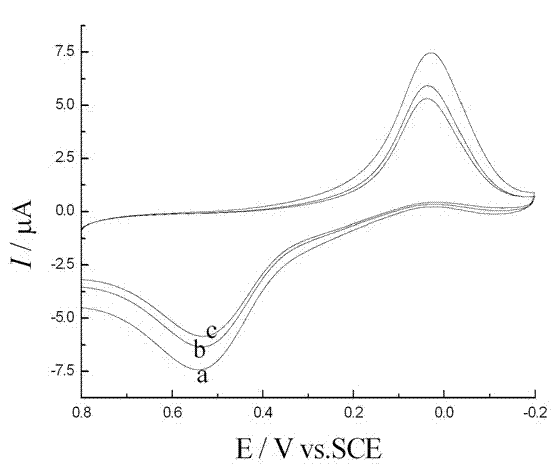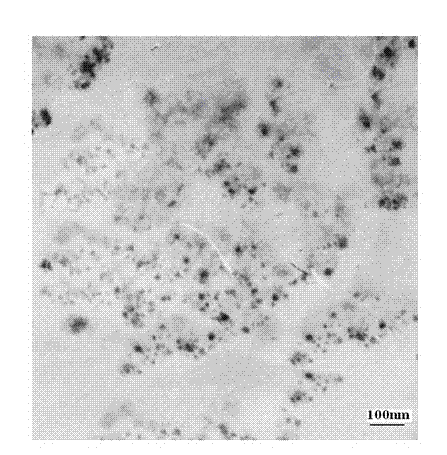Au NPs-CeO2@PANI (polyaniline) nanocomposite, preparation method thereof and glucose biological sensor manufactured by utilizing nanocomposite
A nanocomposite material and biosensor technology, applied in the field of glucose biosensors, can solve problems such as restricting use, and achieve the effects of maintaining biological activity, high sensitivity, and broadening the linear range
- Summary
- Abstract
- Description
- Claims
- Application Information
AI Technical Summary
Problems solved by technology
Method used
Image
Examples
Embodiment 1
[0037] Example 1: Preparation of Au NPs-CeO 2 @PANI Nanocomposites,
[0038] A, preparation of cerium dioxide nanoparticles and gold nanoparticles;
[0039] Take 30mL 0.15mol / L Ce(NO 3 ) 3 solution, add 6mL3%H 2 o 2 , and then add 2mol / L ammonia water while stirring to form a yellow precipitate, until the pH value is greater than 9, so that the precipitation is complete. The pellet was centrifuged twice for about 15 min each time. Add dilute HNO to the precipitate 3 (1mol / L) to adjust the pH to 1.4, and peptize at a water bath temperature of 60°C to form light yellow and transparent CeO 2 Hydrosol. CeO 2 The sample obtained after the water sol was evaporated to dryness was calcined at 550 °C for 2 h to obtain nano-CeO 2 powder;
[0040] Add 3 mL of trisodium citrate solution (0.034 mol / L) into a three-necked flask filled with 100 mL of water, heat to boiling, quickly inject 1 mL of chloroauric acid solution (0.024 mol / L) under stirring, and adjust the heat source so...
Embodiment 2
[0045] Example 2: Using Au NPs-CeO 2 @PANI nanocomposite immobilized glucose oxidase to make glucose biosensor.
[0046] (1) Platinum base electrodes with a diameter of 2 mm are made of 0.3 and 0.5 μm Al 2 o 3 After the polishing powder is polished into a mirror surface, it is ultrasonically cleaned with acetone, absolute ethanol and deionized water for 5 minutes in sequence;
[0047] (2) At 0.5% H 2 SO 4 Electrochemical pretreatment is carried out in (1), and the substrate electrode treated in (1) is scanned by cyclic voltammetry at a scan rate of 50mV / s for 30 cycles at -0.4~+1.0V until it is stable;
[0048] (3) The prepared Au NPs-CeO 2 @PANI was dissolved in deionized water at a concentration of 1mg / mL, sonicated for 1h; take 3μL Au NPs-CeO 2 Mix @PANI with 3 μL 1mg / μL glucose oxidase (GOD) and 1 μL 1.0% chitosan (Chit) thoroughly, then drop on the surface of the platinum disk electrode treated by the above (2) step, and let it dry at room temperature, so that A gl...
Embodiment 3
[0062] Example 3: Preparation of Au NPs-CeO 2 @PANI Nanocomposites,
[0063] Take 0.206g CeO 2 Ultrasonic dispersion of nanoparticles in 20mL 1 mol L -1 In the HCl solution, add 1 mL of An (CeO 2 The molar ratio of An to An was 1:0.5), and ultrasonically dispersed for 30 min. Other preparation steps are the same as in Example 1. The catalytic behavior of the modified electrode on glucose oxidase was evaluated by cyclic voltammetry, as shown in figure 1 (b). Compared figure 1 (a), (b), the peak current in (b) is significantly lower than that in (a), because of the excess CeO 2 The addition of , the conductivity of the composite material is reduced, thereby reducing the catalytic ability of glucose oxidase to glucose.
PUM
 Login to View More
Login to View More Abstract
Description
Claims
Application Information
 Login to View More
Login to View More - Generate Ideas
- Intellectual Property
- Life Sciences
- Materials
- Tech Scout
- Unparalleled Data Quality
- Higher Quality Content
- 60% Fewer Hallucinations
Browse by: Latest US Patents, China's latest patents, Technical Efficacy Thesaurus, Application Domain, Technology Topic, Popular Technical Reports.
© 2025 PatSnap. All rights reserved.Legal|Privacy policy|Modern Slavery Act Transparency Statement|Sitemap|About US| Contact US: help@patsnap.com



